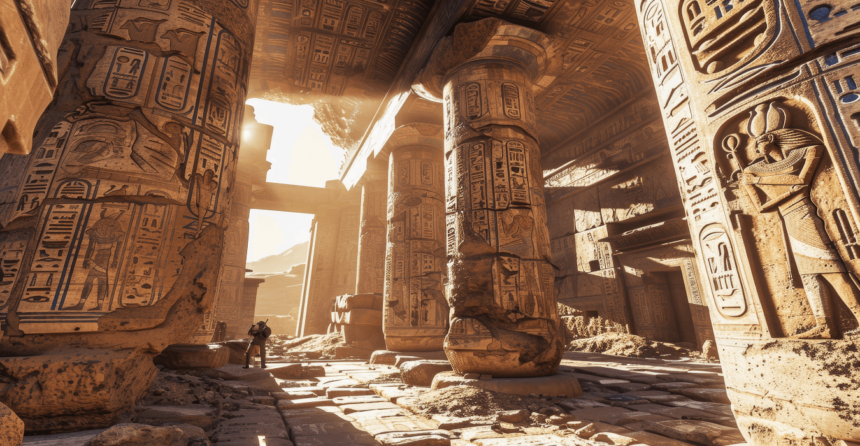Ancient art provides a window into the past by revealing the ideas way of life and inventiveness of long gone civilizations the delicate ceramics of ancient Greece and the pyramids of Egypt are only two examples of the early societies creations that still inspire and impact the current world the term Ancient Artz encompasses not only these artifacts from history but also the comprehension and. Admiration of how these works influenced. Human evolution throughout many regions and societies.
The significance of ancient art its development across various civilizations and its influence on contemporary society will all be discussed in this article we will explore important topics like the functions of ancient art recurring motifs and the media employed by these artist we’ll also look at the ways in which ancient art continues to have cultural significance and. Serve as an inspiration for modern artists.
The Purpose of Ancient Art
Beyond just being aesthetically pleasing the early forms of art had other functions as well ancient artwork frequently had profound political social and religious implications it served as a medium for early human communities to record significant event communicate and express their values ancient art was closely related to rituals and collective values in contrast to modern art which is frequently viewed as a means of self expression.
Religious and Spiritual Significance
A great deal of prehistoric art was produced in homage to god spirits or ancestors for example religious rituals and artistic expression were closely related in ancient Egypt the culture strong belief in life after death is reflected in the tomb murals and statues created to accompany the deceased in the afterlife. In a same vein the enormous sculptures of the god in temples served as focal points for devotion and ceremonial gifts in addition to being emblems of authority.
Mesoamerican civilizations including the Maya and Aztecs employed art to depict gods and supernatural entities numerous of their paintings and sculptures which represent the link between the material and spiritual realms were incorporated into pyramids temples and ceremonial events.
Commemorative and Political Functions
A great deal of prehistoric art was produced in homage to god spirits or ancestor for example religious rituals and. Artistic expression were closely related in ancient Egypt the culture strong belief in life after death is reflected in the tomb murals and statues created to accompany the deceased in the afterlife. In a same vein the enormous sculptures of the god in temples served as focal points for devotion and. Ceremonial gifts in addition to being emblems of authority.
Mesoamerican civilizations including the Maya and Aztecs employed art to depict gods and supernatural entities numerous of their paintings and sculptures which represent the link between the material and spiritual realms were incorporated into pyramids temples and ceremonial events.
Common Themes in Ancient Art
Even though ancient art varied greatly throughout cultures and geographical area some themes were always present these subjects frequently included nature the divine life and death.
Nature and the Environment
The natural surroundings served as a source of inspiration for many ancient artists for instance the vegetation and animals of the Nile River are frequently portrayed in ancient Egyptian art illustrating the civilization’s reliance on the river for sustenance natural environment plant and animals were frequently shown in symbolic ways signifying rebirth fertility or the bond between humans and the natural world.
Similar to this intricate representations of landscapes animals and celestial bodies were used in ancient Chinese art especially during the Han and tang dynasties to honor nature these motif which demonstrated the harmony between people and the universe were frequently endowed with philosophical or spiritual importance.
The Human Form
An important issue in many ancient societies was the representation of the human body probably the most well known example of this is found in ancient Greek art which placed a strong emphasis on idealized human forms that represented harmony beauty and physical perfection. Greek sculptures that honor athletic excellence and the human form like the Discobolus the discus thrower perfectly capture the essence of the culture.
On the other hand stylized exaggerated shapes were used to depict the human figure in early African art such as that found in the Nok culture rather of being accurate portraits of specific people these images frequently functioned as ceremonial artifact symbolizing ancestors or spiritual entities.
The Afterlife and Eternity
The idea of an afterlife or perpetual existence dominated art in many ancient cultures the purpose of the great Egyptian tombs like the pyramids was to guarantee the pharaohs eternal life extensive artwork such as statues wall murals and fine carvings was found inside tombs to help the dead in the hereafter.
The enormous terracotta Army made up of life sized sculptures was constructed in ancient China to go to the afterlife with Emperor Qin Shi Huang these intricate representations of warrior horses and chariots show the culture’s belief in the emperor lifelong protection and his or her ability to rule even after death.
Mediums and Techniques in Ancient Art
The materials and methods employed by prehistoric artists were shaped by the particular requirements of the artworks they produced as well as the resources accessible in their localities the inventiveness of ancient painter is well recognized as they employed a diverse array of media to convey their concepts.
Stone Carving and Sculpture
Stone carving is one of the oldest and most durable types of ancient art enabling societies to produce statues and colossal buildings the enormous statues of pharaohs and god as well as the elaborate hieroglyphs that covered temples and tombs were typically carved out of limestone and sandstone in ancient Egypt.
Marble was preferred by the Greeks who are well known for their sculptures because of its fine texture and capacity to depict minute details. Greek stone carvers expertise is demonstrated by the Parthenon in Athens which features ornate friezes and statues.
Pottery and Ceramics
Another important medium for ancient painters was pottery especially in Mesoamerica ancient Greece and ancient China. Greek ceramics served as both functional art and ornamental art frequently adorned with mythological or everyday subjects on vases and amphorae painters were able to create incredibly realistic and emotional sceneries through the use of techniques like red and black figure painting.
The invention of porcelain in China during the Tang and Song dynasties was a noteworthy advancement in both technology and aesthetics Chinese ceramics gained international recognition for their exquisite glazes and elaborate designs which influenced ceramic traditions all around the world.
Metalwork
An important artistic endeavor in antiquity was metalworking especially in societies that had easy access to materials like gold silver bronze and iron ancient Egyptians were expert at crafting elaborate jewelry and funerary masks like the well known mask of Tutankhamun which was crafted from gold and set with priceless stones.
The Moche civilization of Peru created intricate metalwork in the ancient Americas such as ceremonial vessels and gold and silver jewelry. These artworks demonstrated the culture’s skill and symbolic use of materials frequently featuring animals god and warriors.
The Evolution of Ancient Art Across Cultures
Ancient societies developed traded and interacted with one another as their art changed the creation of distinctive styles and developments in art was affected by the ideas and techniques that were exchanged between many cultures.
The Influence of Trade
Trade routes like the Silk Road, facilitated the flow of artistic ideas and methods in addition to good for instance India was impacted by the diffusion of Hellenistic art following Alexander the Great’s conquests buddha images peculiar to Gandhara a region in modern day Pakistan were created through a synthesis of Greek and Indian creative influences.
In a similar vein the Roman Empire which ruled over a sizable portion of Europe Africa and. Asia incorporated creative elements from the civilizations it subjugated this diversity is reflected in the style of Roman art which blends elements of Middle Eastern Greek and. Egyptian art into a unique imperial aesthetic.
Cultural Diffusion and Innovation
Ancient art developed into a mashup of cultural concepts as a result of interactions between civilizations through migration trade and. Conquest for instance the art of ancient Mesopotamia had an impact on the Levant and Egypt two nearby regions with its vivid glazed bricks the renowned Ishtar Gate of Babylon influenced artistic and. Architectural advancement across Persia and beyond.
Similarly the invention of writing systems like cuneiform and hieroglyphs enabled. Ancient painters to fuse written language with visual art producing visually stunning and. Intellectually stimulating works.
The Legacy of Ancient Art
Ancient civilizations artistic output has left a profound legacy that still affect contemporary culture ancient artwork and. Artifacts are on exhibit at museums all around the world safeguarding these cultural treasures for upcoming generations in addition modern artist find inspiration in the idea methods and. Aesthetics of antiquity producing. Work that speak to the present while still referencing the past.
Inspiration for Modern Artists
A lot of contemporary artists incorporate classical shapes and motifs into their works after drawing. Inspiration from ancient art for example Pablo Picasso fascination for African art inspired him to create fresh methods for capturing the human form whereas Henry Moore was impacted by the shapes and. Forms of ancient sculpture.
Preservation and Cultural Heritage
Preserving historical artwork is essential to keeping a link to the past new artifacts are always being discovered through archeological research providing new perspectives on past societies ancient art conservation organizations work to shield. These priceless pieces from deteriorating environmental conditions theft and time.
Conclusion
Early civilizations values beliefs and aspirations are reflected in the artwork of antiquity which stands as a tribute to human ingenuity and inventiveness these work which range from the magnificent pyramids of Egypt to the exquisite ceramics of ancient Greece never cease to amaze and instruct we can learn more about the history we share and the ongoing legacy of human expression by conserving and studying old art Ancient Artz is about appreciating great pieces of art as well as realizing how much of an impact they have had on the world we live in today.






